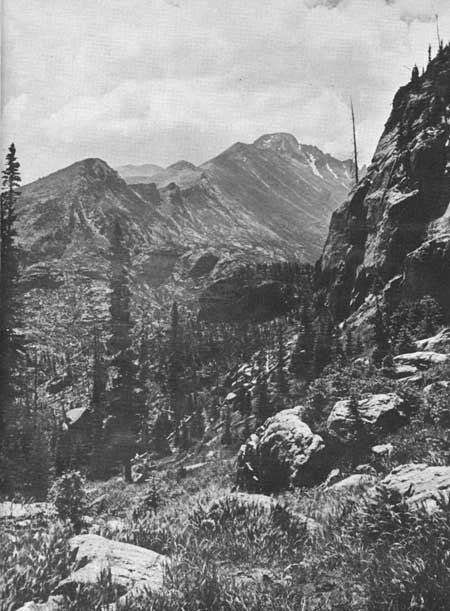|
ROCKY MOUNTAIN National Park |
 |
The Mountains Are Mantled With Plants
Having seen that the present mountains are the result of past events, we should not be surprised to learn that the plant cover of the park is also dependent on what has occurred before. Although we are inclined to think of a plant community, such as a forest, as a permanent fixture, actually it is a dynamic, never-stagnant population of individual living things, and resembles a community of people in some ways.
Just as human populations ebb and flow through periods of great numerical growth and dominance, followed by decline and engulfment by invading peoples, so do vegetation types go through periods of dominance and decline. When certain conditions of climate and soil prevail, those kinds of plants best adapted to such conditions will dominate the scene. As conditions change, the flora will change.
In Rocky Mountain National Park, we assume that toward the end of the Ice Age most of the high altitude landscape was either ice-covered or barren, like our present-day rock piles above timberline. As the ice melted and disappeared, the bare rocks of the canyons were exposed, and lakes occupied what are now the meadows. The climate was changing, though, and the rather sparse arctic-type plant life was superseded by another vegetation complex, except on the very tops of the mountains.
The original arctic-type vegetation was presumably connected with that of the regions bordering the Arctic Ocean. The present tundra of the high country in the park is an island of arctic-type vegetation, surrounded on all sides by plant communities of lower latitudes. Will it be engulfed some day and replaced by surrounding plant types? If the climate continues to moderate, the answer may be "Yes."
Most of the original sparse arctic flora has already disappeared. The bare rocks were first invaded by lichens—those plant pioneers still to be seen on bare rocks in the park. In the thin soil formed by their life processes other primitive plants became established. As the climate moderated and soils formed where bare rocks formerly existed, a new vegetation complex replaced the old.
We suppose that all sorts of plants got started on this new land, but only those species which happened to be adapted for the particular conditions of their time would last long enough to become well established and to produce ample seeds for future generations. This natural selective elimination of plants which did not adjust to the changing conditions results in the dominance of certain well-adjusted species. In this way according to scientists, a climax vegetation develops for a particular situation. As long as the climate remains about the same, the climax vegetation remains fairly static, but, at best, climax is relative and judged by the time perspective of man.
 RUGGED CLIFFS AND MIGHTY PEAKS ARE SPECTACULAR PRODUCTS OF GEOLOGIC FORCES. —A. R. Leding photo. |
Although it has been thousands of years since these plant communities first started on the glaciated bedrock, the struggle for dominance among the plants still goes on. Conditions are not yet completely static and probably never will be. The meadows, the forests, and the barrens of today may be quite different in a distant tomorrow.

|

|
| NPS History | History & Culture | National Park Service | Contact |
|
Last Modified: Sat, Nov 4 2006 10:00:00 pm PST |


